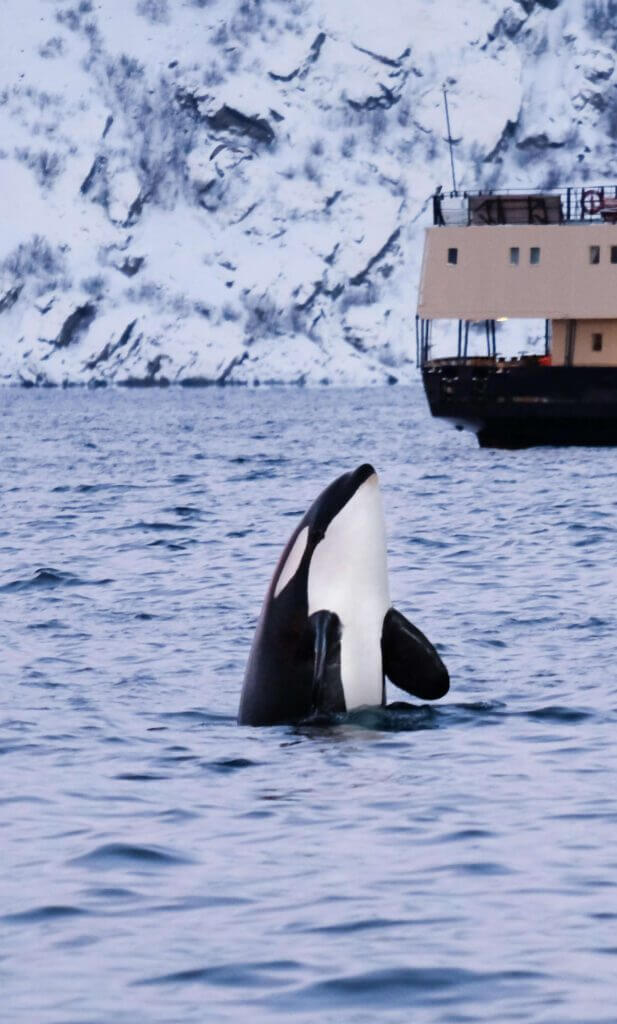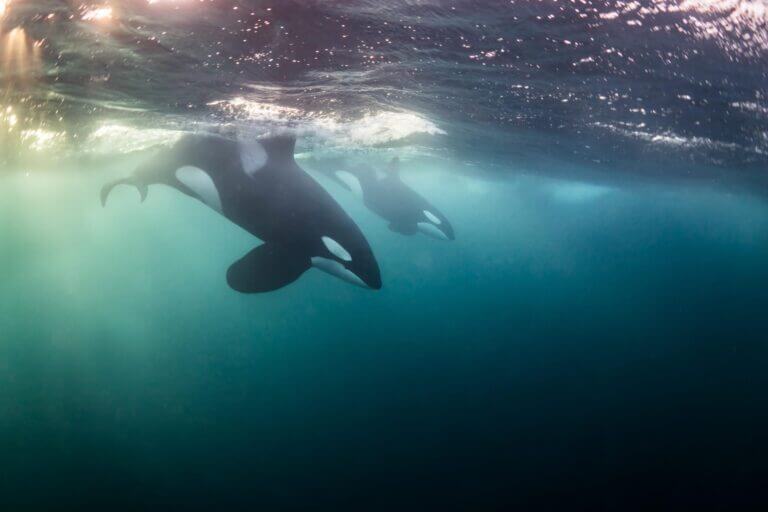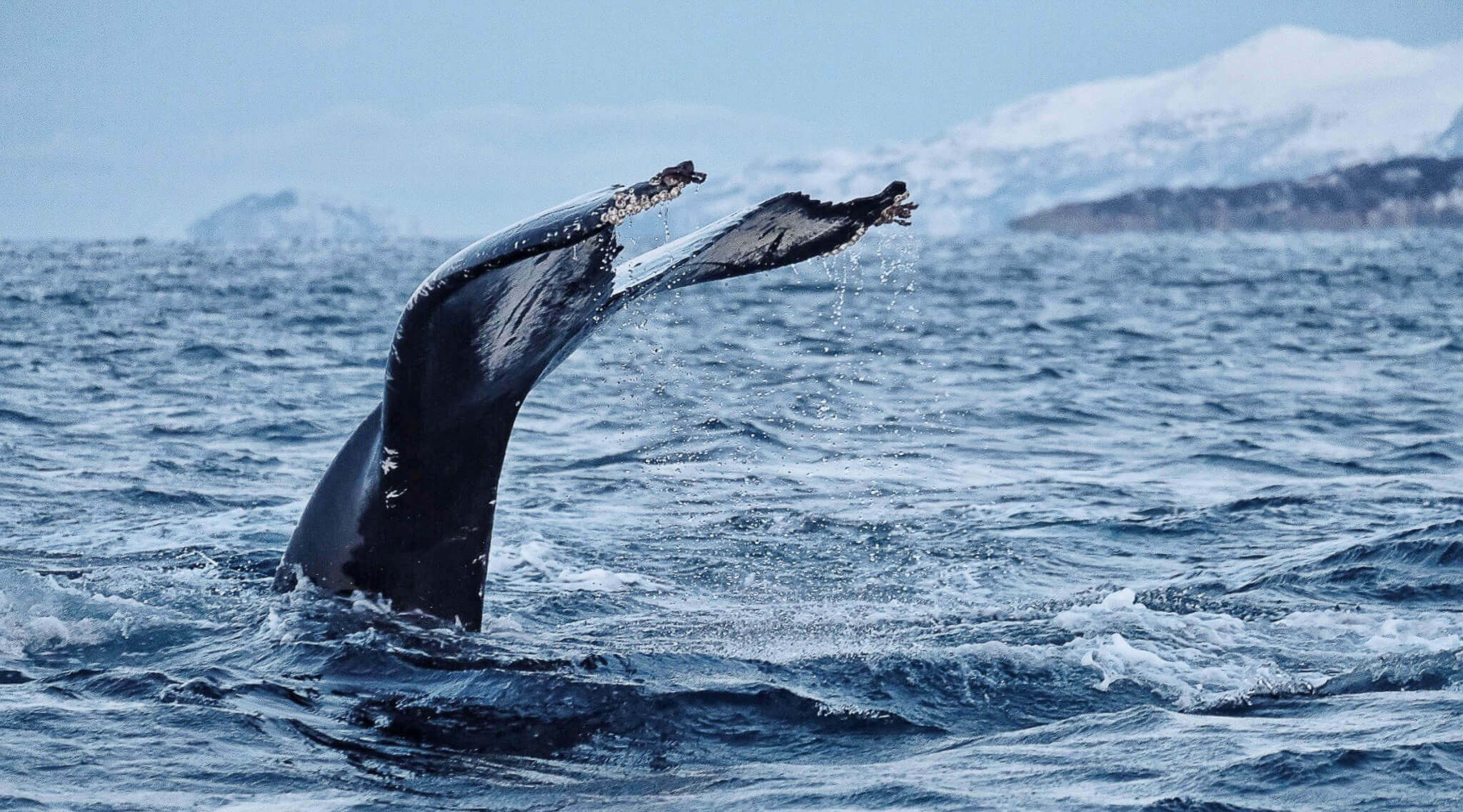Whale watching in Norway
Whale watching season 2023/2024 is over - the whales have started migrating south. We welcome them back from October 2024.
Skjervøy, about 250 km north of Tromsø, has become a popular destination for whale watching safaris. People travel there each winter to get a close-up look at humpback whales and orcas while they feed on herring. Check out our whale watching tours from Tromsø. Observing these majestic marine mammals only a short distance from your boat is an unforgettable experience!
But did you also know that you can also whale watch in Northern Norway during the summer months? From Lofoten or Andenes, on a Rigid Inflatable Boat or on a small cruise, the choice is yours!Our whale watching tours

We have several whale watching tours from Tromsø. You can travel by boat directly from Tromsø by joining either a Silent Whale Watching tour on board a hybrid catamaran or a Whale Safari with a Guarantee on board a large and comfortable catamaran.
These two boats, designed for whale watching, have viewing platforms and panoramic windows. These whale-watching trips last six to eight hours in total.

If you are prone to seasickness in the open water, we recommend going on a Whale Watching by Rigid Inflatable Boat (RIB) with transport by land. On this tour, you will be transported by bus to Skjervøy (four hours each way) before spending about three hours on a RIB encountering the whales closer to the water level.
Our whale watching tours



During a whale watching tour, distance and minimal noise are maintained to avoid disturbing the whales, in accordance with the official guidelines.
Whale watching is one of our most popular tours, so we recommend booking as soon as possible.

When and where can you see whales in Troms?
The best time to go on a whale watching tour from Tromsø is during winter.
The whale watching season usually lasts from early November to late January, when the whales migrate from fjord to fjord following the herring.
The herring migrates from its summer feeding grounds in the Barents Sea to its spawning area out in the Atlantic Ocean in February. From October-November to early February, the herring finds its way along the coast of Northern Norway.
In the winter of 2017, the herring migrated from the coast off Tromsø northwards towards Skjervøy in the Lyngenfjord region, and the whales followed in search of a feast!
The reasons for the herring’s migration have not been identified and it’s possible that they migrate somewhere else.
Consequently, it’s hard to predict exactly where and when we can see whales in this part of Northern Norway.

When and where can you see whales in Troms?
The best time to go on a whale watching tour from Tromsø is during winter.
The whale watching season usually lasts from early November to late January, when the whales migrate from fjord to fjord following the herring.
The herring migrates from its summer feeding grounds in the Barents Sea to its spawning area out in the Atlantic Ocean in February. From October-November to early February, the herring finds its way along the coast of Northern Norway.
The marine mammals you can see on your whale watching safari
The marine mammals you can see on your whale watching safari
Orcas (killer whales)
The orca, or killer whale, is the largest member of the oceanic dolphin family. They are easily recognisable by their distinctive black and white body and large dorsal fin (up to 2 m high for males!).
Orcas are smart and social. They live and hunt together in pods (family groups of up to 40 individuals), each pod sharing a sophisticated and unique culture (what to eat, where to find it and how to catch it…) that is passed down through generations. Orcas also have a variety of communicative and distinctive sounds.


Orcas (killer whales)
The orca, or killer whale, is the largest member of the oceanic dolphin family. They are easily recognisable by their distinctive black and white body and large dorsal fin (up to 2 m high for males!).
Orcas are smart and social. They live and hunt together in pods (family groups of up to 40 individuals), each pod sharing a sophisticated and unique culture (what to eat, where to find it and how to catch it…) that is passed down through generations. Orcas also have a variety of communicative and distinctive sounds.
The orca, or killer whale, is the largest member of the oceanic dolphin family. They are easily recognisable by their distinctive black and white body and large dorsal fin (up to 2 m high for males!).
Orcas are smart and social. They live and hunt together in pods (family groups of up to 40 individuals), each pod sharing a sophisticated and unique culture (what to eat, where to find it and how to catch it…) that is passed down through generations. Orcas also have a variety of communicative and distinctive sounds.

These cetaceans are one of the world’s most powerful predators and are at the top of the ocean food chain.
They can speed up to 55 km/h and hunt all kinds of species such as fish, rays, seals, penguins, dolphins and even sharks or whales (hence their name of “killer whales”).
They can swallow up to 230 kilos of food a day! In Northern Norway, they use an impressive method to hunt herring.
After tracking the fish with their sonar, they generate bubbles and sounds to round up the shoal and hit them with their tails before devouring them.

These cetaceans are one of the world’s most powerful predators and are at the top of the ocean food chain.
They can speed up to 55 km/h and hunt all kinds of species such as fish, rays, seals, penguins, dolphins and even sharks or whales (hence their name of “killer whales”).
They can swallow up to 230 kilos of food a day! In Northern Norway, they use an impressive method to hunt herring.
After tracking the fish with their sonar, they generate bubbles and sounds to round up the shoal and hit them with their tails before devouring them.
Humpback whales
Humpback whales are known for their complex songs, which can be heard up to 65 km away. They are also well known for breaching, although scientists are not sure if this behaviour is meant to clean pests from their skin or is simply for fun.
Humpbacks migrate every year between their feeding grounds in the cold waters of the poles and breeding grounds in the warm waters of the tropics. They can travel around 5,000 km on a regular basis between these two areas!
Humpback whales use a complex tactic to feed called “bubble netting”. A pod of 2 to 15 whales hunt together. They surround the fish and trap them inside a spiral of bubbles before swimming through to catch the fish in their open mouths.

They then filter the water out through their baleen plates, which act as a sieve to keep the fish in their mouths. This way, a single whale can eat up to 500 kg of herring in a day!
Sometimes humpbacks also steal the herring gathered up by the killer whales.

Humpback whales
Humpback whales are known for their complex songs, which can be heard up to 65 km away. They are also well known for breaching, although scientists are not sure if this behaviour is meant to clean pests from their skin or is simply for fun.
Humpbacks migrate every year between their feeding grounds in the cold waters of the poles and breeding grounds in the warm waters of the tropics. They can travel around 5,000 km on a regular basis between these two areas!
Humpback whales use a complex tactic to feed called “bubble netting”. A pod of 2 to 15 whales hunt together. They surround the fish and trap them inside a spiral of bubbles before swimming through to catch the fish in their open mouths.
They then filter the water out through their baleen plates, which act as a sieve to keep the fish in their mouths. This way, a single whale can eat up to 500 kg of herring in a day!
Sometimes humpbacks also steal the herring gathered up by the killer whales.

During a whale watching tour, distance and minimal noise are maintained to avoid disturbing the whales, in accordance with the official guidelines.
Whale watching is one of our most popular tours, so we recommend booking as soon as possible.
Generally, in the winter months of November to January, whales can be spotted in the fjords in Troms (orcas and humpback whales mainly).
Whale watching is one of the most popular tours departing from Tromsø and heading to the coastal area where whales have been spotted.
Book as soon as possible as this is one of our best sellers. Don’t miss the chance to see these beautiful huge marine mammals.
Generally, in the winter months of November to January, whales can be spotted in the fjords in Troms (orcas and humpback whales mainly).
Whale watching is one of the most popular tours departing from Tromsø and heading to the coastal area where whales have been spotted.
Book as soon as possible as this is one of our best sellers. Don’t miss the chance to see these beautiful huge marine mammals.
